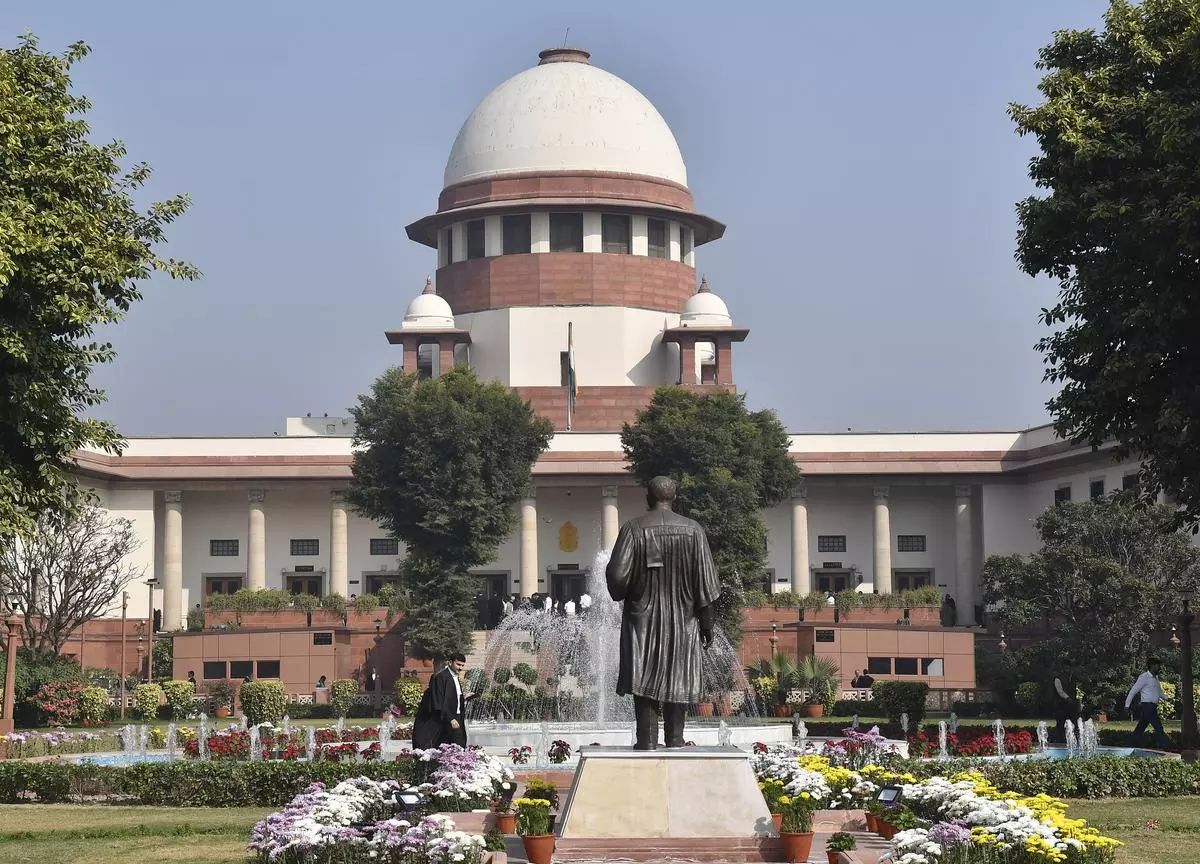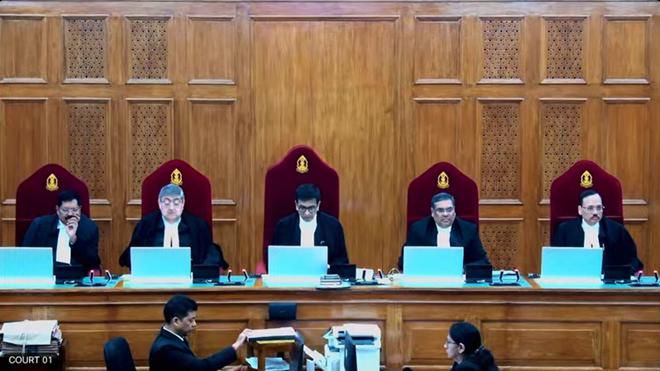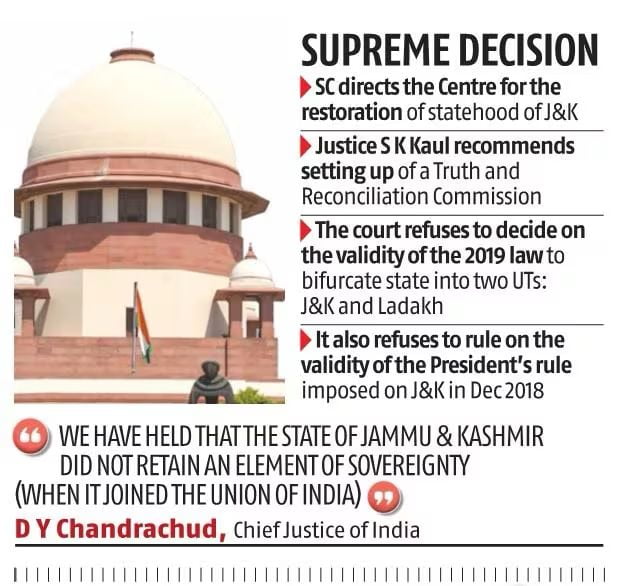On December 11, 2023, the five-judge constitution bench of the Supreme Court gave a unanimous judgement, upholding the validity of the abrogation of Article 370. Abrogation is the act of formally ending a law or an agreement. As a result, the special status of the state was revoked. However, the Supreme Court while pronouncing the judgement, declared that the statehood of Jammu & Kashmir shall be restored, and elections should be held in the state by September 2024. But, they did uphold the validity of the reorganisation of Ladakh into union territory.

Photo Credits: The Hindu
Evolution of Article 370
While Indian independence in 1947 witnessed most princely states joining either India or Pakistan, Jammu and Kashmir chose to join neither. On August 12, 1947, Jammu and Kashmir formally requested a standstill agreement from both India and Pakistan. While Pakistan agreed to the proposal, India declined and instead urged the Maharaja to send a representative for bilateral discussions. Maharaja Hari Singh was facing internal disturbances against his Dogra reign. Moreover, in June 1947, approximately 60,000 former army personnel (mostly from Poonch), initiated a campaign refraining from paying taxes in protest against the Maharaja. On August 14-15, the hoisting of Pakistani flags by Muslims in Poonch led to the imposition of martial law, fueling discontent among Muslim subjects. This created tensions and Pakistan issued warning notes to the Maharaja.
On October 22, 1947, Pakistan launched Operation Gulmarg and mobilised tribals from the North-West Frontier Province. Pakistan eventually invaded Kashmir on October 24th, 1947,with an army of soldiers and tribesmen carrying weapons. As a result, Maharaja Hari Singh appealed to India for help in protecting his state. He sent his representative Sheikh Abdullah to Delhi on his behalf to ask for India’s help.To secure some autonomy for Jammu and Kashmir, Maharaja Hari Singh signed the “Instrument of Accession (IoA)” on October 26, 1947, allowing India’s administrative role to only defence, foreign affairs, and communications.
On 17th October 1949, Article 370 was drafted by Sh. N Gopalaswami Ayyangar, who was part of the drafting committee of the Constituent Assembly of India. It was added to the Constitution of India as a temporary provision as the first article of Part XXI of the Constitution, titled ‘Temporary, Transitional and Special Provisions. The article granted special status to J&K and allowed the state to draft its constitution. On October 31, 1951, a Constituent Assembly was set up for the same. It exempted the state from the application of other articles of the Indian Constitution, except Article 1, which states that “India, that is Bharat, shall be a union of states,” and Article 370 itself.
Along with this, Article 35A was also introduced by a Presidential Order in 1954, on the recommendation of the J&K Constituent Assembly. The Article gave the power to the Constituent Assembly to define the “permanent residents” of the state, and their special rights and privileges, giving them additional entitlements, such as exclusive access to government jobs and scholarships, educational opportunities and owning property. Non-outsiders did not have access to either of these things.
On November 17, 1956, the constitution was adopted, which defined the relation of J&K with India but also laid down the provisions that provided autonomy to the state. After fulfilling its purpose, it was dissolved in 1957.
Dissolution of Article 370
On 5th August, 2019, the President of India issued the Constitution (Application to Jammu and Kashmir) Order, 2019 which replaced the Presidential Order of 1954 and amended Article 370. The special status of Jammu and Kashmir was revoked, granted by Article 370, which led to the reorganisation of the state into the two Union territories of Jammu and Kashmir and Ladakh. This significantly altered the relationship between the state of Jammu and Kashmir and the Union.The central government’s reasoning centred on two primary arguments,firstly, the provisions of Article 370 had created separation and alienation within the state, and secondly, that its presence hindered J&K’s socio-economic development and full integration with the Indian Union.
However, this move was highly debated, and 23 separate petitions were filed by a wide range of individuals and entities, including citizens, political parties, organisations, lawyers, activists, and even retired civil servants, challenging the validity of the abrogation. Some of the primary petitioners were National Conference leader Mohammad Akbar Lone, Advocates M L Sharma, Soayib Qureshi, Muzzafar Iqbal Khan, Rifat Ara Butt, and Shakir Shabir; Hasnain Masoodi, CPI(M) leader Mohammed Yousuf Tarigami. Senior advocates like Kapil Sibal, Gopal Subramanium, Rajeev Dhavan, Zaffar Shah and Dushyant Dave represented the petitioners in the court.
The petitioners and opposition parties and the state’s representatives expressed their concern over the potential implications for the region’s autonomy and the demographic composition of the state (Business Standard).
Details of the Supreme Court case
- Writ Petition (Civil) No. 1099 of 2019: Filed by Manohar Lal Sharma, challenging the President’s orders modifying Article 370 and reorganising Jammu and Kashmir.
- Writ Petition (Civil) No. 1143 of 2019: Filed by Harsh Dev Singh, focusing on the procedural aspects of the abrogation and questioning the lack of consultation with the J&K Assembly.
- Writ Petition (Civil) No. 1144 of 2019: Filed by Ghulam Nabi Nengroo, arguing that the abrogation violated the basic structure of the Constitution and the right to self-determination.
- Writ Petition (Civil) No. 1559 of 2019: Filed by the Indian National Congress, challenging the constitutional validity of the Reorganisation Act.
A five-judge Constitution bench comprising Chief Justice of India (CJI) Justice DY Chandrachud, Justice Sanjay Kishan Kaul, Justice Sanjiv Khanna, Justice BR Gavai and Justice Surya Kant presided over the case. The hearing began on 2nd August 2019. A total of 16 hearings took place for this case.
Court’s findings:
- Issue of sovereignty of Jammu and Kashmir: The petitioners argued that the special status of J&K gave it sovereignty, separate from India. The Court noted Section 3 of J&K’s Constitution explicitly states that “the State of Jammu and Kashmir is and shall be an integral part of the Union of India.” This cancelled out any claim being made about J&K’s internal sovereignty.

Photo Credits: The Economic Times
- Whether Article 370 is temporary or permanent: While initially intended as temporary, the petitioners argued that according to Article 370(3), recommendation of the Constituent Assembly is needed to abrogate Article 370. Clause 3 of Article 370 declares that the President can make changes to this article on the recommendation of the Constituent Assembly of the state. Since J&Ks Constituent Assembly has already been dissolved, there is no other constitutional means to revoke the Article. Thus, making the provision permanent in the constitution. However, the court verdict said that the post-abrogation President can unilaterally take away Jammu and Kashmir’s special status under Article 370(3). This also refuted any questions raised on the legality of the abrogation.
- Lack of consultation with the state government: During the time of abrogation, the state was put under President’s rule. Under this, the governor administers the state on behalf of the President and the President has the power to declare that the state legislature’s powers could be exercised by the Parliament. The President could also either suspend or dissolve the state legislative assembly. In 2019, the Indian government redefined the “Constituent Assembly” to mean the Legislative Assembly of the state, allowing it to take on legislative powers and revoke Article 370. But the petitioners argued that the state government was not consulted. Again relying on Article 370(3), the court said that the President can unilaterally take away Jammu and Kashmir’s special status.
The centre was represented by Solicitor General Tushar Mehta, who argued that the Constitution of Jammu and Kashmir is subordinate to the Indian Constitution. He presented evidence suggesting the J&K Constituent Assembly was primarily a Legislative Assembly engaged in lawmaking activities. He also asserted that reorganisation of Jammu and Kashmir into a Union territory was a temporary measure and its statehood will be re-established in the future.
Supreme Court verdict
After extensive proceedings, the Supreme Court refuted each of these arguments, declared the move to be valid, and asserted that Article 370 was introduced only as a temporary provision. As a consequence of the verdict, the constitution of J&K remains inoperative. Moreover, they also upheld that in situations like when a state is under President’s rule, the Governor or the President can step in and assume the work of the State Legislature. These powers could be kept in check by Judicial scrutiny.

Photo Credit: Business Standard
The Court also ordered the setting up of a Truth and Reconciliation Commission to address human rights violations in the state in a time-bound manner, similar to the one set up in South Africa post-apartheid.
Consequences of abrogation of Article 370
The abrogation of Article 370 has brought about positive social and economic developments for J&K as well as the country. The situation of unrest and instability has shifted towards a surge in economic and infrastructural development. A 23% drop in terrorist recruitment and successful counter-terrorism operations also reflects enhanced security strategies (The Economic Times).
Some of the initiatives taken by the government are the Prime Minister’s Development Package (PMDP) and the Industrial Development Scheme (IDS). These have boosted investment, job creation, and economic growth in the region. Tax revenue has surged by 31%, and the GSDP is expected to grow at 8% against the national 7%. This economic resurgence is empowering locals and laying the foundation for a prosperous future.
Infrastructure development has seen a push, marked by the construction of roads, bridges, tunnels, and power lines. These advancements have shrunk distances, boosted connectivity, and improved the ease of doing business within the region (Business standard, 2021). The benefits of such efforts are reflected in the increased number of tourists flocking to Jammu and Kashmir. In 2022, a staggering 1.62 crore tourists, the highest in India’s history, experienced the region’s breathtaking beauty and cultural richness.
However, the developments can’t diminish the concerns of various stakeholders associated with the recent verdict. One aspect is that of having a unique identity and culture of Kashmir. Revoking the special status of J&K also removed the special provisions of land ownership and employment that were initially only available for Kashmiris. Now, there is a chance that non-Kashmiris may migrate there, leading to increased competition, especially when the state is still yet to achieve its full development potential. The influx of outsiders may also water down the distinct culture of Kashmir.
The abrogation may have also created more disintegration by exacerbating feelings of alienation and resentment among many Kashmiris. A 2022 report by Amnesty International emphasised that this decision could have unintended consequences, potentially leading to social unrest and separatist movements. The ongoing security measures and restrictions on movement have had a significant impact on people’s lives, with many feeling restricted and fearful. This could potentially hinder efforts to foster lasting peace and reconciliation in the region. There has been apprehension about the potential human rights violations in Kashmir. The report also highlighted detention reports, restrictions on freedom of speech and assembly, and allegations of torture in the state.
While the Supreme Court’s verdict on Article 370 will bring positive benefits in terms of economic and infrastructural development for the people of Jammu and Kashmir, it may also exacerbate challenges of cultural dilution and possible human rights violations. Continued monitoring and open dialogue with stakeholders will be crucial in assessing the long-term implications of this decision.
